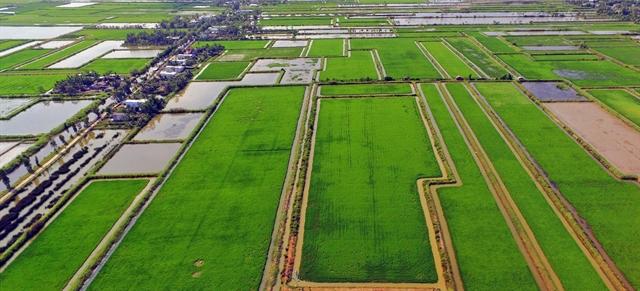 Society
Society

 |
| Shrimp-rice farming fields in Cà Mau Province’s Thới Bình District. The fields have certification for meeting Global Aquaculture Stewardship Council standards. — VNA/VNS Photo Huỳnh Anh |
CÀ MAU — The shrimp-rice farming model has been implemented effectively and developed sustainably in the southernmost province of Cà Mau.
It entails farmers rotating between breeding shrimp in the dry season and growing rice in the rainy season on the same fields or farm both simultaneously.
The model is well adapted to climate change, especially saltwater intrusion into rivers, and produces clean shrimp and rice as farmers use few chemicals for either, according to local authorities.
Thới Bình District, which has one of the largest shrimp-rice farming areas in the province, has seen farmers’ incomes steadily improve over many years.
Its Trí Lực Commune has 700ha of organic shrimp-rice farms, equivalent to a quarter of its total aquaculture area.
Nearly 600ha fields belonging to 252 households have been granted the Global Aquaculture Stewardship Council (ASC) certificate.
Many farmers breed black-tiger shrimp, white-legged shrimp or giant river prawns and high-quality rice varieties such as ST24 and ST25, two of the world’s best.
All shrimp and rice produced under the model have guaranteed buyers since farmers and the commune’s co-operatives have established linkages.
Lê Văn Mưa, director of the Trí Lực Service and Shrimp-Rice Farming Co-operative, said the linkages are extensive and help develop the model sustainably.
“Getting the [ASC] certificate helps improve product value and offers farmers high and steady incomes.”
The average income from the shrimp-rice farming was VNĐ65 million (US$2,600) per hectare per year in 2013-21, two or three times the income from farming only rice, according to the Thới Bình District Bureau of Agriculture and Rural Development.
Nguyễn Hoàng Bạo, chairman of the Thới Bình District People’s Committee, said the model is sustainable, reduces pollution, helps adapt to climate change, and its products meet the requirements in demanding global markets.
Farmers could also breed various aquatic species such as river giant prawns, fishes and crabs to increase profits, he said.
Farmers breeding giant river prawns have had steady incomes in recent years.
Lương Thanh Tiền, who has a 4ha farm in U Minh District’s Nguyễn Phích Commune, earn an average of VNĐ200 million ($8,000) a year.
He grows organic rice that fetches high prices, he said.
His family’s life has improved significantly after adopting the shrimp-rice farming model, he added.
Trần Quốc Sự, deputy secretary of the Nguyễn Phích Commune Party's Committee, said more farmers would be taught breeding techniques.
Cà Mau, the country’s largest shrimp producer, has 300,000ha under aquaculture, including more than 36,300ha of shrimp-rice farming fields.
The province is expanding shrimp-rice farming, mostly in coastal areas, according to its Department of Agriculture and Rural Development.
It hopes to have more than 40,000ha of shrimp-rice farming fields with organic or ASC certificates by 2030.
Châu Công Bằng, deputy director of the department, said his agency has worked with companies and non-governmental organisations to develop shrimp-rice farming projects that are granted international certificates.
The province plans to expand shrimp-rice farming fields in Thới Bình District that meet ASC standards to 10,000ha, he said.
High incomes
Farmers who breed giant river prawns under the shrimp-rice farming model have begun harvesting the crustaceans and are set for a bumper harvest and high prices.
They have been bred on nearly 20,000ha, including 16,000ha in Thới Bình and 3,000ha in U Minh.
Farmers said they are harvesting 300-500 kilogrammes of prawns per hectare and earning VNĐ50-60 million ($2,000-2,400).
Traders are buying the creatures at VNĐ85,000-95,000 ($3.4-3.8) a kilogramme. VNS




